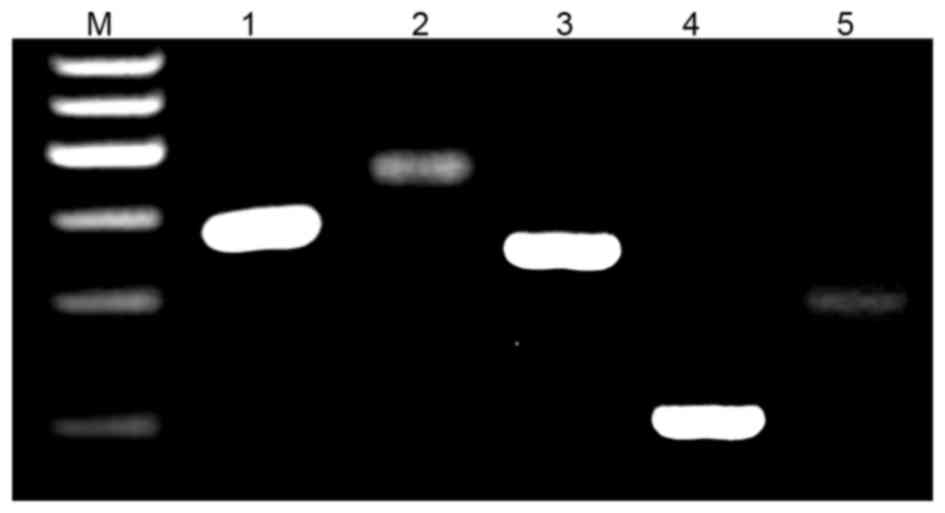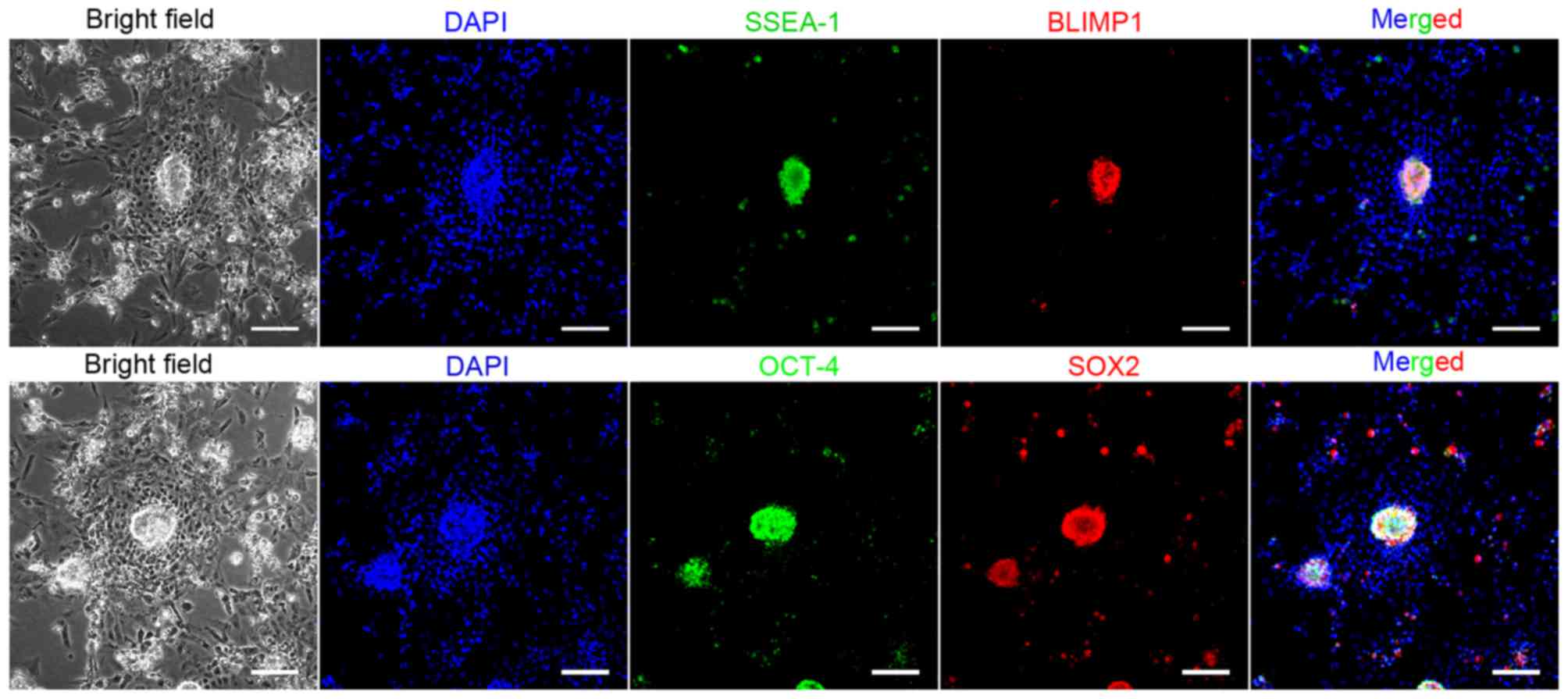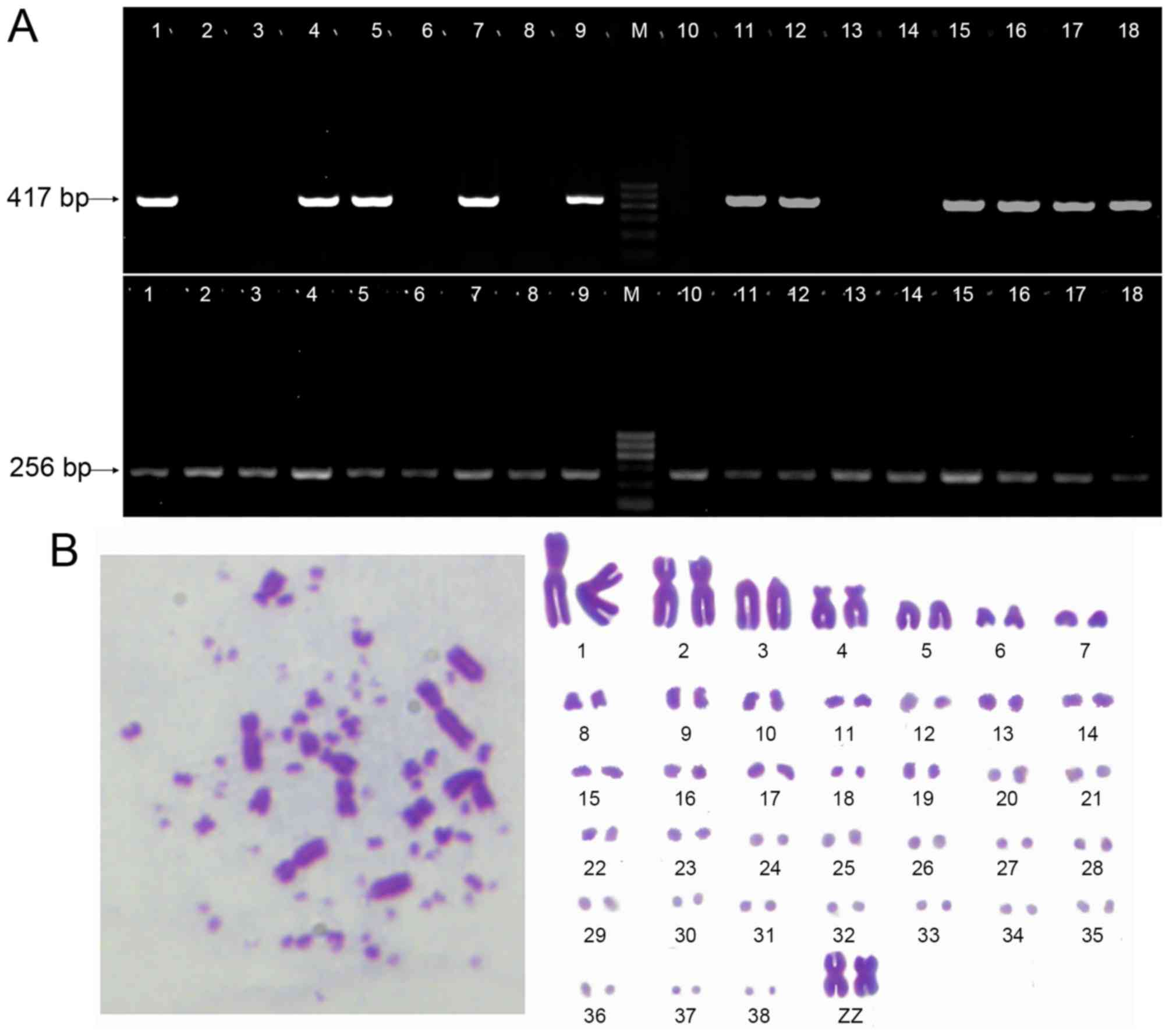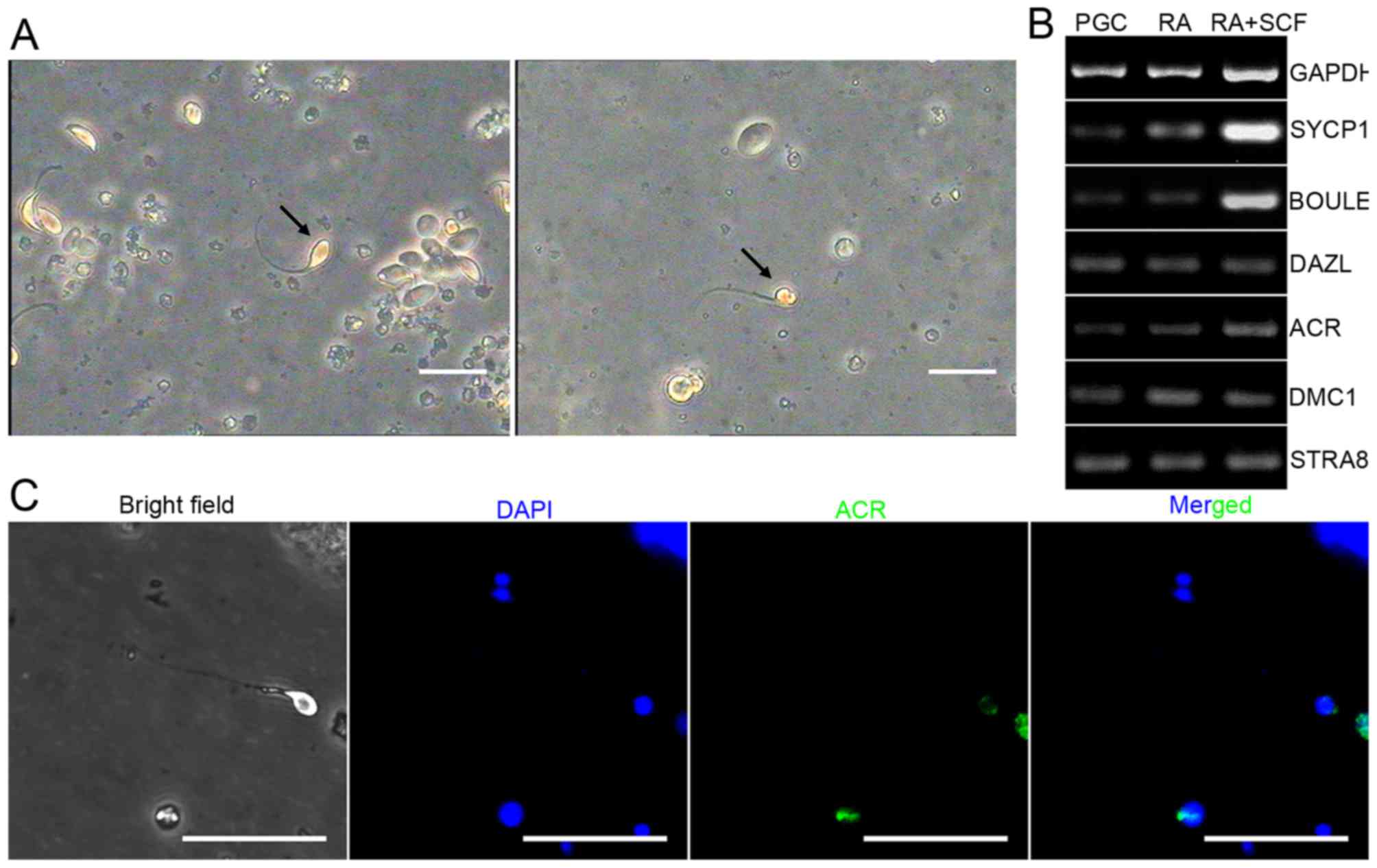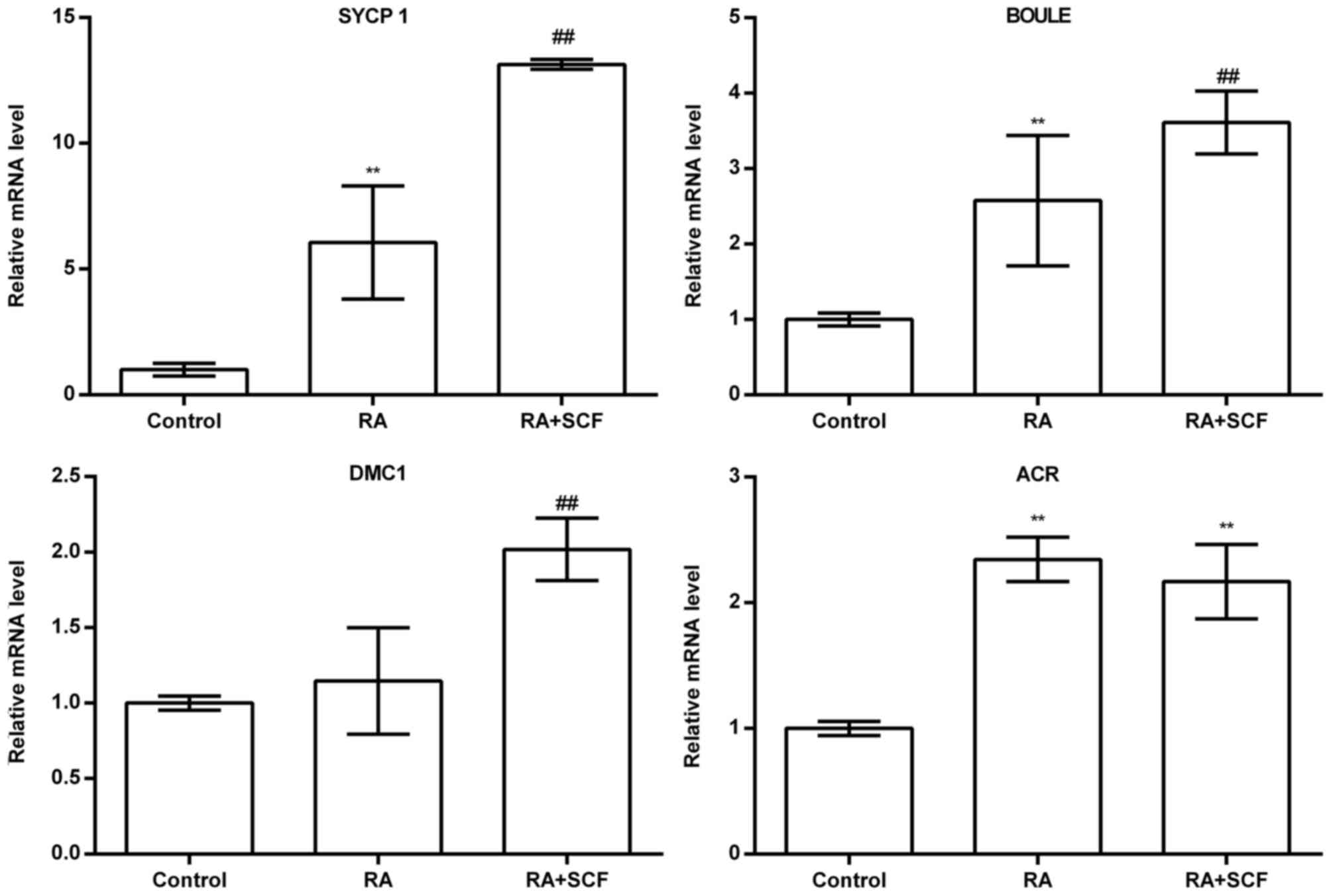Generation of haploid spermatids from chicken embryonal primordial germ cells
- Authors:
- Published online on: March 30, 2018 https://doi.org/10.3892/ijmm.2018.3602
- Pages: 53-60
Abstract
Introduction
Germ cell can generate sperm and oocyte which are the basis for sexual reproduction (1). To produce a functional sperm, an unformed male germ cell undergoes a coordinated set of events that are collectively called spermatogenesis. In many animals, sperm cells are derived from a first germline cell population of primordial germ cells (PGCs) that are set aside early in embryogenesis (2,3). In the male gonads, PGCs initiate differentiation toward spermatogenesis.
For more than a century, researchers have been focusing on spermatogenesis in vitro (4). Previous studies have indicated that retinoic acid (RA) can trigger differentiation of GS cells (5,6). RA, the active derivative of vitamin A, controls the entry of germ cells into meiosis in avian, mice and humans (1,7,8). It has been demonstrated that RA and stem cell factor (SCF) are crucial for the maintenance of normal spermatogenesis in rodents and human spermatogonial stem cells (SSCs) (6,9). SCF has been evidenced to induce human and mouse SSCs to differentiate into haploid spermatids in vitro (6,10) and the SCF/KIT system plays key role in SSC proliferation and entrance meiosis (11). Moreover, RA has been indicated to trigger germ cell meiotic origination in the chicken (12). Unfortunately, there is no evidence showing the functions of SCF in induction of PGCs spermatogenesis. Therefore, RA and SCF were chosen in this study to induce the differentiation of chicken PGCs.
In this study, we successfully generated haploid spermatids by RA and SCF inducing chicken PGCs directly in vitro. We have indicated that RA leads to PGC differentiation, and SCF can improve the efficiency of induction. In addition to providing an in vitro model for chicken PGC spermatogenesis through RA and SCF stimulation. Our results support the recent protocol that RA can trigger germ cell differentiation without somatic testicular cells (13). Our results demonstrated that chicken PGCs could be induced into male gametes. It may be a great animal model for study of spermatogenesis. We have built an efficient proposal to induce haploid spermatids in vitro, it could provide abundant operating materials for spermatozoal function research promoting the use of stem cell transplanting engineering in clinical infertility.
Materials and methods
Experimental animals
All the animal procedures were approved by the Institutional Animal Care and Use Committee of Chinese Academy of Agricultural Sciences. Chicken embryos were provided by the Experimental Animal Base Institute of Animal Sciences, Chinese Academy of Agricultural Sciences, Beijing, China. The use of animals in research and all experimental procedures involving chicken embryos were conducted in accordance with the guidelines established by the Institutional Animal Care and Use Committee at the University of Medicine and Dentistry of New Jersey-Robert Wood Johnson Medical School.
Isolation and in vitro culture of chicken PGCs
Fertile eggs were incubated at 38°C and 50% humidity for 5.5 day. Gonads of the chicken embryos developed at stage 28 (14), were isolated using stereoscopic microscope, then embryonic gonadal tissues were collected and dissociated with 0.125% trypsin-0.02% ethylenediaminetetraacetic acid (EDTA). After neutralized with Dulbecco's modified Eagle's medium (DMEM) containing 10% fetal bovine serum (FBS), the gonadal cells were collected by centrifugation.
The precipitated cells were re-suspended in PGC cell culture medium, which consisted of DMEM medium replenished with 10% FBS (Gibco, Grand Island, NY, USA), 2% chicken serum and supplemented with 10 ng/ml of human SCF (hSCF), 10 U/ml of leukemia inhibitory factor (LIF), 20 ng/ml of human basic fibroblast growth factor (bFGF) (all from PeproTech, London, UK), 1X penicillin/streptomycin (Life Technologies, Grand Island, NY, USA). Cell suspensions were seeded into 6-well culture plates with chicken embryonic fibroblasts (CEFs) as feeding layer (15) at a density of 1×104/well, and cultured at 37.5°C in 5% CO2. The PGC colonies were dissociated and moved into fresh plates with CEFs using trypsin-EDTA treatment for subculture (16).
Embryonic tissue collection
Following separation of the embryonic gonadal tissues respectively, ~10 mg of embryonic tissue was collected and placed in 10 ml of digestion buffer (10 mM Tris, 1 mM EDTA, 1% SDS, pH 8.0 containing 10 mg/ml Proteinase-K) and incubated overnight at 45°C. Samples were cooled to 4°C and centrifuged at 12,000 rpm for 10 min. The supernatant was transferred to a fresh micro-centrifuge tube, diluted to 200 µl with water and used in PCR reactions.
PAS staining and alkaline phosphatase activity assay
For PAS staining, the cell colonies of the cultured chicken PGCs were fixed with 4% paraformaldehyde for 20 min and washed 3×5 min with phosphate-buffered saline (PBS). The cell colonies were then submerged to periodic acid solution (Sigma-Aldrich, St. Louis, MO, USA) for 5 min at room temperature. After washing twice with PBS, the cell colonies were immersed in Schiff's solution (Sigma-Aldrich) for 15 min at room temperature. Then PAS-stained PGC colonies were observed under an inverted microscope after washing twice with PBS. Alkaline phosphatase (AKP) activity was detected by AKP substrate kit (Sigma-Aldrich) according to the manufacturer's instruction. Images were captured with a computer-assisted video camera (IX-71 inverted research microscope; Olympus, Tokyo, Japan).
Karyotyping
The chicken PGCs were incubated in 0.5 µg/ml colcemid (Karyomax; Invitrogen, Carlsbad, CA, USA) at 37.5°C in 5% CO2 for 5 h, then the chicken PGCs were dissociated with 0.125% trypsin-0.02% EDTA. The cells were then centrifuged and resuspended in 0.075 M KCl solution at 37°C. After 30 min, the cells were centrifuged at 200 × g for 8 min and the pellet was fixed in 3:1 methanol: glacial acetic acid. For metaphase analysis the cell suspension was dropped on the frozen glass slides, stained with Giemsa (Amresco, Solon, OH, USA) and analysed for the 6 pairs of macro-chromosomes and the sex chromosomes. At least 20 metaphase spreads were counted for every chicken PGC passage.
Immunocytochemistry staining
For immunocytochemical analysis, the chicken PGCs or differentiated cells from PGCs were fixed in 4% paraformaldehyde (PFA) in PBS and permeabilized with 0.4% Triton X-100. Blocking with 10% goat serum was performed for 1 h prior to the incubation with primary antibodies. The cells were incubated with primary antibodies anti-SSEA-1, BLIMP1, Oct4, Sox2 or ACR at 4°C overnight, followed by goat anti-rabbit FITC or anti-mouse Alexa Fluor 594 (red)-labeled secondary antibody for 1 h. DAPI was used to label the cell nuclei, and images were captured with a fluorescence microscope (Nikon TE-2000-E inverted microscope; Nikon, Tokyo, Japan).
RNA isolation and PCR analysis
Total RNA was extracted from the PGC colonies at third passage or induced cells after 48 h using TRIzol (Invitrogen). After DNase I treatment to remove the potential contamination of genomic DNA, 2.0 µg of total RNA were reverse transcribed into cDNA using an RNA PCR kit (AMV) Ver.3.0 (Takara Bio Co., Dalian, China). The gene expression analysis was detected by ABI StepOnePlus Real-time PCR thermal cycling instrument (Applied Biosystems, Foster City, CA, USA). The stage specific genes CVH, BLIMP1 and the stem cell specific genes Pouv and Nanog (the primer information is shown in Table I), the Xhol repeat sequence and 18S ribosomal gene (the primer information is shown in Table II) and the hallmarks of meiotic germ cells and haploid germ cell gene acrosin (ACR), DNA meiotic recombinase 1 (DMC1), BOULE, Dazl, protamine 1 (PRM1) and synaptonemal complex protein 1 (SYCP1) were detected (the primer information is shown in Table III), the PCR reactions were performed by the PCR Master Mix kit (Promega, Madison, WI, USA), and the PCR products were visualized by electrophoresis on 2.5% agarose gels. The qPCR was carried out on an ABI 7300 HT real-time PCR machine (Applied Biosystems) with the reaction volume of 30 µl consisting of complementary DNA from 15 ng of the original RNA template, 400 nM of each of the gene-specific forward and reverse primers, and 15 µl SYBR Premix Ex Taq (Takara Bio Co.). Then, qRT-PCR was carried out in triplicate with a SYBR Premix Ex Taq in an ABI 7500 Real-time PCR detection system (Applied Biosystems). After normalization with glyceraldehyde 3-phosphate dehydrogenase (GAPDH), relative RNA levels in the samples were calculated by the comparative threshold cycle method. The sequences of primers for PCR are listed in Table III. The ΔΔCt method was used to calculate relative fold-change values between samples.
Induction of sperm
The induction solution which consisted of DMEM medium replenished with 10% FBS, 2% chicken serum and supplemented with RA and SCF were prepared. The PGCs at passage 3 were chosen and reseeded with induction solution into 24-well plates at a density of 5×104/ml in an incubator in 5% CO2 at 37°C.
Flow cytometry
Flow cytometry was performed to quantify DNA content of chicken embryonal PGCs with different density of RA and SCF treatment. In brief, the samples were washed twice in PBS and fixed in cold 70% ethanol, then incubated with a solution containing 25 µg/ml propidium iodide (PI) (Sigma-Aldrich), 40 µg/ml RNase (Invitrogen), and 0.3% Tween-20 in PBS at room temperature for 20 min, cells were analyzed with a FACSCalibur system (Beckman Coulter, Brea, CA, USA).
Statistical analysis
Statistical analyses of the data were performed with a one-way ANOVA, followed by the Tukey-Kramer honestly significant difference (HSD) test for the three sets of results. A P-value of <0.05 was considered statistically significant. Statistical analyses were done with a JMP Statistical Discovery software (SAS Institute, Cary, NC, USA).
Results
Characterization of PGCs
In this study, we established a stable PGC cell line (Fig. 1A) which could culture for a long time and subculture on an average of 3 days, and it supported the later sperm induction usage. The PGCs expressed the stage specific genes CVH and Blimp1, the stem cell specific genes Pouv and Nanog (Fig. 2), were strongly positive for AKP and PAS staining (Fig. 1B and C). We examined the three passages of PGCs which expressed stage specific surface makers SSEA-1, BLIMP1 and stem cell makers Oct4 and Sox2 by immunocytochemistry staining (Fig. 3), these results suggested unique characteristics for the PGCs cell line.
To distinguish whether PGC is a female or a male the W chromosome-specific Xhol family and ribosomal repeat primers previously established (17) were used. Both pairs of primers perform as expected on female and male DNA in separate reactions. The W-repeat primers produce a product only with female DNA, while the ribosomal gene primers produce a product with both male and female DNA (Fig. 4A). Furthermore, we checked the chromosome karyotype of the fourth passage. Karyotype analysis revealed that the PGCs were diploid (2n=78) with 9 pairs of macrochromosomes and 30 pairs of microchromosomes. The sex chromosome type was ZZ (Fig. 4B). PGCs karyotypes had no variation after subculture.
Effect of RA on PGCs meiosis
RA has been demonstrated to play essential roles in promoting germ cell spermatogenesis in chicken. Thus various density of RA were chosen to induce PGC cells spermatogenesis. The PGCs were treated without or with RA for differentiation. Different concentrations of RA ranging from 0.5 to 2 nmol/ml, were used to optimize the condition for inducing spermatogenesis of chicken PGCs. qRT-PCR assays showed that the expression of ACR was the highest in PGCs treated with 1 nmol/ml RA compared to other concentrations of RA; the expression of SYCP1 was higher in PGCs treated with 0.5 and 1 nmol/ml RA than other concentrations of RA; the expression of BOULE was higher in PGCs treated with 0.5, 1 and 2 nmol/ml RA than control, and thus 1 nmol/ml RA was used to induce the differentiation of chicken PGCs (Fig. 5).
RA and SCF promote PGC meiotic efficiency
Previous studies evidenced that SCF was essential for the maintenance of normal spermatogenesis (6,9). SCF is a cytokine that binds to the c-kit receptor which is expressed in PGCs and spermatogonia (18). SCF/c-kit plays an essential role in the regulation of spermatogenesis. Studies with type A spermatogonia have shown that SCF induces DNA synthesis and proliferation (10). Thus we added the SCF into induction solution with RA for inducement. Morphological analysis displayed a different shape of PGCs with or without RA and SCF treatment. Excitingly, more male germ cells became enlarged and elongated in PGCs treated with RA and SCF compared to the group without RA or SCF (Fig. 6A). Finally, we examined the differentiated cells which expressed sperm specific surface marker ACR by immunocytochemistry staining (Fig. 6C).
We next assessed the differentiation potential of PGCs. RT-PCR showed that the transcripts of SYCP1, BOULE, DAZL, STRA8, DMC1 and ACR, hallmarks of meiotic germ cells and haploid germ cells, respectively (1,19), were enhanced in PGCs with RA and SCF treatment compared to the control without SCF and RA (Fig. 6B), and real-time PCR revealed that the mRNA levels of SYCP1, BOULE, DMC1 and ACR were significantly upregulated in PGCs with RA and SCF treatment compared to the control without SCF or RA (Fig. 7). Considered the above, these results evidence that RA and SCF promote the differentiating efficiency of chicken PGCs into meiotic male germ cells and haploid cells at transcriptional level.
RA and SCF induce increase of haploid cell population
To evaluate the ploidy levels of chicken PGCs without or with RA and SCF treatment, flow cytometry were used to analyze DNA contents. Notably, the haploid cells originated from 10.8 to 15.5% in PGCs with RA treatment, 18.3% in PGCs with RA and SCF treatment compared to the control (Fig. 8). These data further implicate that RA and SCF improve the differentiating efficiency of PGCs into haploid spermatids.
Discussion
We examined the efficiency of in vitro expansion of chicken PGCs which were cultured for 6 weeks. Establishment of the long-term in vitro culture system for PGCs could provide numerous cells for research (20). In our culture system the PGCs were strongly positive for AKP and PAS staining (21,22) and its karyotype kept no variation after subculture. The size of PGCs, large amounts of glycogen granules in the cytoplasm and large nuclei, are bigger than somatic cells. This result implicated that the PGC wants normal growth and development.
To obtain conclusive evidence that the PGCs were derived from male chicken embryos, we investigated whether these cells presented female or male phenotypes. The female and male gonads of the chicken embryos developed at stage 28 are morphologically similar known as the indifferent gonad. Gonads of female and male, respectively, develop into ovarian and testicular characteristics after the indifferent stage. Previous studies demonstrated a kind of repetitive DNA sequences from W chromosome present specifically in the female chicken (17,23). Thus, we evidenced that a PCR reaction, containing primers specific to both the W chromosome sequence and the 18S ribosomal gene, can readily make a clear distinction between female and male DNA. The karyotype analysis is also an important research means of cytogenetics. It can not only quickly identify mutated chromosomes, but also distinguish male and female phenotypes (6,24). Combining these two methods, we were able to separate the male PGCs from chicken embryos.
RA has been shown to be a meiosis-inducing substance. Several studies have suggested the importance of RA in germ cell meiotic initiation (6,9,25). Our results suggested, in agreement with previous studies, that 1 nmol/ml RA induced PGC meiosis efficiently. SSCs originate from PGCs. During avian and mammalian development, PGCs migrate along the dorsal mesentery into the genital ridges, and their differentiation lasts several weeks (26,27), while PGC differentiation into spermatigonia and spermatigonia to reach the haploid sperm needs a long time-period (28). SCF has been reported to be crucial in spermatogonial differentiation as well as meiotic initiation (10). Our results indicated that RA and SCF promote the greater differentiating efficiency of chicken PGCs into meiotic male germ cells and haploid cells then RA was induced. Crosstalk between RA and the SCF pathway stimulated differentiation of male germ cells toward the meiotic stages (29).
Various types of detection methods, including quantitative PCR, RT-PCR and FACS assays were used to assess the differentiation potential of chicken PGCs. The expression of several genes for meiotic and haploid cells, including SYCP1, BOULE, DMC1 and ACR (1,6), in chicken PGCs were evidently upregulated after treatment with RA and SCF. SYCP1, major component of the transverse filaments of synaptonemal complexes (SCS), can be used to measure the synaptonemal complex, which formed between homologous chromosomes during meiotic prophase (30). BOULE, with a key role in germ cell development, is a member of the DAZ gene family. Loss of this gene function results in azoospermia. Previous studies found that they originally appeared in the meiotic G2/M transition (31). DMC1 encodes the DNA strand-exchange protein, which is essential for repairing double-strand DNA breaks during mitosis and meiosis and meiotic homologous recombination (32). ACR, a typical serine proteinase with trypsin-like specificity, is the key proteinase present in the acrosome of mature spermatozoa. Research demonstrated that the mRNA for proacrosin is expressed only in the postmeiotic stages of spermatogenesis (33). The DNA content of chicken PGCs with RA and SCF treatment was detected by FACS. Although the DNA ploidy levels show that PGCs have the ability of spontaneous differentiation into haploid cells, the number of haploid cells was obviously increased in chicken PGCs by RA and SCF treatment. These markers for meiosis and postmeiosis obviously show that RA and SCF promote the differentiation of chicken PGCs into the post-meiotic stage and finally differentiate into haploid spermatids.
In this study, we evidenced that RA and SCF are effective in promoting the differentiation of chicken PGCs from gonadal ridges into cells with phenotypic features, and DNA content of haploid spermatids. This study thus offers an approach to generate functional haploid spermatids from PGCs, which could provide male gametes for clinical treatment and transgenic animal research.
Acknowledgments
This study was supported by the National Natural Science Foundation of China (no. 31472099).
References
|
Mi Y, He B, Li J and Zhang C: Progesterone regulates chicken embryonic germ cell meiotic initiation independent of retinoic acid signaling. Theriogenology. 82:195–203. 2014. View Article : Google Scholar : PubMed/NCBI | |
|
Feng LX, Chen Y, Dettin L, Pera RA, Herr JC, Goldberg E and Dym M: Generation and in vitro differentiation of a spermatogonial cell line. Science. 297:392–395. 2002. View Article : Google Scholar : PubMed/NCBI | |
|
Saitou M and Yamaji M: Germ cell specification in mice: Signaling, transcription regulation, and epigenetic consequences. Reproduction. 139:931–942. 2010. View Article : Google Scholar : PubMed/NCBI | |
|
Martinovitch PN: Development in vitro of the mammalian gonad. Nature. 139:4131937. View Article : Google Scholar | |
|
Dann CT, Alvarado AL, Molyneux LA, Denard BS, Garbers DL and Porteus MH: Spermatogonial stem cell self-renewal requires OCT4, a factor downregulated during retinoic acid-induced differentiation. Stem Cells. 26:2928–2937. 2008. View Article : Google Scholar : PubMed/NCBI | |
|
Yang S, Ping P, Ma M, Li P, Tian R, Yang H, Liu Y, Gong Y, Zhang Z, Li Z, et al: Generation of haploid spermatids with fertilization and development capacity from human spermatogonial stem cells of cryptorchid patients. Stem Cell Rep. 3:663–675. 2014. View Article : Google Scholar | |
|
Childs AJ, Cowan G, Kinnell HL and Anderson RA: Saunders PT. Retinoic Acid signalling and the control of meiotic entry in the human fetal gonad. PLoS One. 6:e202492011. View Article : Google Scholar : PubMed/NCBI | |
|
Ohta K, Lin Y, Hogg N, Yamamoto M and Yamazaki Y: Direct effects of retinoic acid on entry of fetal male germ cells into meiosis in mice. Biol Reprod. 83:1056–1063. 2010. View Article : Google Scholar : PubMed/NCBI | |
|
Bowles J, Knight D, Smith C, Wilhelm D, Richman J, Mamiya S, Yashiro K, Chawengsaksophak K, Wilson MJ, Rossant J, et al: Retinoid signaling determines germ cell fate in mice. Science. 312:596–600. 2006. View Article : Google Scholar : PubMed/NCBI | |
|
Feng LX, Ravindranath N and Dym M: Stem cell factor/c-kit upregulates cyclin D3 and promotes cell cycle progression via the phosphoinositide 3-kinase/70 S6 kinase pathway in spermatogonia. J Biol Chem. 275:25572–25576. 2000. View Article : Google Scholar : PubMed/NCBI | |
|
Mithraprabhu S and Loveland KL: Control of KIT signalling in male germ cells: What can we learn from other systems. Reproduction. 138:743–757. 2009. View Article : Google Scholar : PubMed/NCBI | |
|
Smith CA, Roeszler KN, Bowles J, Koopman P and Sinclair AH: Onset of meiosis in the chicken embryo; evidence of a role for retinoic acid. BMC Dev Biol. 8:852008. View Article : Google Scholar : PubMed/NCBI | |
|
Zhou Q, Li Y, Nie R, Friel P, Mitchell D, Evanoff RM, Pouchnik D, Banasik B, McCarrey JR, Small C, et al: Expression of stimulated by retinoic acid gene 8 (Stra8) and maturation of murine gonocytes and spermatogonia induced by retinoic acid in vitro. Biol Reprod. 78:537–545. 2008. View Article : Google Scholar | |
|
Hamburger V and Hamilton HL: A series of normal stages in the development of the chick embryo. J Morphol. 88:49–92. 1951. View Article : Google Scholar : PubMed/NCBI | |
|
Choi JW, Kim S, Kim TM, Kim YM, Seo HW, Park TS, Jeong JW, Song G and Han JY: Basic fibroblast growth factor activates MEK/ERK cell signaling pathway and stimulates the proliferation of chicken primordial germ cells. PLoS One. 5:e129682010. View Article : Google Scholar : PubMed/NCBI | |
|
Liu CX, Wang WL, Zhao RY, Wang HT, Liu YY, Wang SY and Zhou HM: Isolation, culture, and characterization of primordial germ cells in Mongolian sheep. In Vitro Cell Dev Biol Anim. 50:207–213. 2014. View Article : Google Scholar | |
|
Clinton M, Haines L, Belloir B and McBride D: Sexing chick embryos: A rapid and simple protocol. Br Poult Sci. 42:134–138. 2001. View Article : Google Scholar : PubMed/NCBI | |
|
Rossi P, Sette C, Dolci S and Geremia R: Role of c-kit in mammalian spermatogenesis. J Endocrinol Invest. 23:609–615. 2000. View Article : Google Scholar : PubMed/NCBI | |
|
West JA, Park IH, Daley GQ and Geijsen N: In vitro generation of germ cells from murine embryonic stem cells. Nat Protoc. 1:2026–2036. 2006. View Article : Google Scholar | |
|
Shiue YL, Tailiu JJ, Liou JF, Lu HT, Tai C, Shiau JW and Chen LR: Establishment of the long-term in vitro culture system for chicken primordial germ cells. Reprod Domest Anim. 44:55–61. 2009. View Article : Google Scholar | |
|
Jung JG, Kim DK, Park TS, Lee SD, Lim JM and Han JY: Development of novel markers for the characterization of chicken primordial germ cells. Stem Cells. 23:689–698. 2005. View Article : Google Scholar : PubMed/NCBI | |
|
Wang Y, Hou L, Li C, Guan W, Chen L, Li X, Yue W and Ma Y: Isolation, culture and biological characteristics of primordial germ cells from Beijing fatty chicken. J Reprod Dev. 56:303–308. 2010. View Article : Google Scholar : PubMed/NCBI | |
|
Tone M, Nakano N, Takao E, Narisawa S and Mizuno S: Demonstration of W chromosome-specific repetitive DNA sequences in the domestic fowl Gallus g domesticus. Chromosoma. 86:551–569. 1982. View Article : Google Scholar | |
|
Nishida C, Ishijima J, Ishishita S, Yamada K, Griffin DK, Yamazaki T and Matsuda Y: Karyotype reorganization with conserved genomic compartmentalization in dot-shaped microchromosomes in the Japanese mountain hawk-eagle (Nisaetus nipalensis orientalis, Accipitridae). Cytogenet Genome Res. 141:284–294. 2013. View Article : Google Scholar : PubMed/NCBI | |
|
Eguizabal C, Montserrat N, Vassena R, Barragan M, Garreta E, Garcia-Quevedo L, Vidal F, Giorgetti A, Veiga A and Izpisua Belmonte JC: Complete meiosis from human induced pluripotent stem cells. Stem Cells. 29:1186–1195. 2011. View Article : Google Scholar : PubMed/NCBI | |
|
Childs AJ and Anderson RA: Experimental approaches to the study of human primordial germ cells. Methods Mol Biol. 825:199–210. 2012. View Article : Google Scholar | |
|
Macdonald J, Glover JD, Taylor L, Sang HM and McGrew MJ: Characterisation and germline transmission of cultured avian primordial germ cells. PLoS One. 5:e155182010. View Article : Google Scholar : PubMed/NCBI | |
|
Amann RP: The cycle of the seminiferous epithelium in humans: A need to revisit. J Androl. 29:469–487. 2008. View Article : Google Scholar : PubMed/NCBI | |
|
Pellegrini M, Filipponi D, Gori M, Barrios F, Lolicato F, Grimaldi P, Rossi P, Jannini EA, Geremia R and Dolci S: ATRA and KL promote differentiation toward the meiotic program of male germ cells. Cell Cycle. 7:3878–3888. 2008. View Article : Google Scholar : PubMed/NCBI | |
|
Türeci O, Sahin U, Zwick C, Koslowski M, Seitz G and Pfreundschuh M: Identification of a meiosis-specific protein as a member of the class of cancer/testis antigens. Proc Natl Acad Sci USA. 95:5211–5216. 1998. View Article : Google Scholar : PubMed/NCBI | |
|
Kee K, Angeles VT, Flores M, Nguyen HN and Reijo Pera RA: Human DAZL, DAZ and BOULE genes modulate primordial germ-cell and haploid gamete formation. Nature. 462:222–225. 2009. View Article : Google Scholar : PubMed/NCBI | |
|
Habu T, Taki T, West A, Nishimune Y and Morita T: The mouse and human homologs of DMC1, the yeast meiosis-specific homologous recombination gene, have a common unique form of exon-skipped transcript in meiosis. Nucleic Acids Res. 24:470–477. 1996. View Article : Google Scholar : PubMed/NCBI | |
|
Zahn A, Furlong LI, Biancotti JC, Ghiringhelli PD, Marijn-Briggiler CI and Vazquez-Levin MH: Evaluation of the proacrosin/acrosin system and its mechanism of activation in human sperm extracts. J Reprod Immunol. 54:43–63. 2002. View Article : Google Scholar : PubMed/NCBI |




